Report on Coaching and Mentoring: Types, Benefits, and Roles
VerifiedAdded on 2022/09/14
|19
|6197
|13
Report
AI Summary
This report examines coaching and mentoring processes within organizations, highlighting their role in individual and organizational development. It differentiates between coaching, which focuses on improving capabilities and competencies, and mentoring, which provides expert support. The report details the benefits for various stakeholders, including enhanced decision-making skills and overall effectiveness. Different types of coaching and mentoring, such as performance coaching, executive coaching, career coaching, online mentoring, peer mentoring, and line manager mentoring, are discussed. The role of line managers in providing support and feedback is emphasized, along with factors like organizational values, culture, objectives, L&D strategy, and opportunity analysis, which are crucial for successful implementation. The report concludes with recommendations for optimizing coaching and mentoring programs to foster employee growth and organizational success, addressing current scenarios and suggesting improvements for future implementation.

qwertyuiopasdfghjklzxcvbnmqw
ertyuiopasdfghjklzxcvbnmqwert
yuiopasdfghjklzxcvbnmqwertyu
iopasdfghjklzxcvbnmqwertyuio
pasdfghjklzxcvbnmqwertyuiopa
sdfghjklzxcvbnmqwertyuiopasdf
ghjklzxcvbnmqwertyuiopasdfgh
jklzxcvbnmqwertyuiopasdfghjkl
zxcvbnmqwertyuiopasdfghjklzx
cvbnmqwertyuiopasdfghjklzxcv
bnmqwertyuiopasdfghjklzxcvbn
mqwertyuiopasdfghjklzxcvbnm
qwertyuiopasdfghjklzxcvbnmqw
Running Head: COACHING AND MENTORING
0
Implementing Coaching and Mentoring
Student Name:
Student University:
ertyuiopasdfghjklzxcvbnmqwert
yuiopasdfghjklzxcvbnmqwertyu
iopasdfghjklzxcvbnmqwertyuio
pasdfghjklzxcvbnmqwertyuiopa
sdfghjklzxcvbnmqwertyuiopasdf
ghjklzxcvbnmqwertyuiopasdfgh
jklzxcvbnmqwertyuiopasdfghjkl
zxcvbnmqwertyuiopasdfghjklzx
cvbnmqwertyuiopasdfghjklzxcv
bnmqwertyuiopasdfghjklzxcvbn
mqwertyuiopasdfghjklzxcvbnm
qwertyuiopasdfghjklzxcvbnmqw
Running Head: COACHING AND MENTORING
0
Implementing Coaching and Mentoring
Student Name:
Student University:
Paraphrase This Document
Need a fresh take? Get an instant paraphrase of this document with our AI Paraphraser
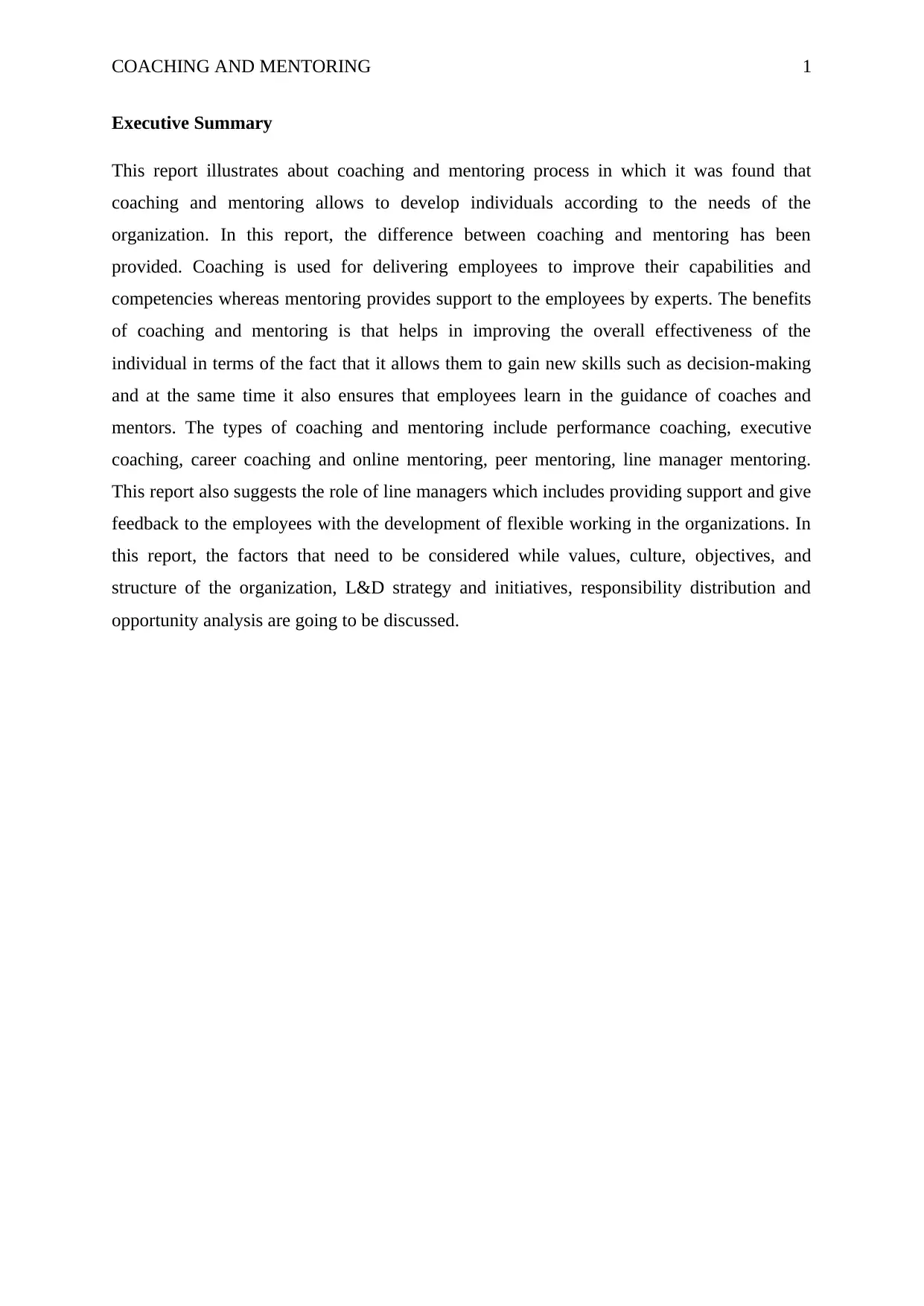
ertyuiopasdfghjklzxcvbnmqwert
COACHING AND MENTORING 1
Executive Summary
This report illustrates about coaching and mentoring process in which it was found that
coaching and mentoring allows to develop individuals according to the needs of the
organization. In this report, the difference between coaching and mentoring has been
provided. Coaching is used for delivering employees to improve their capabilities and
competencies whereas mentoring provides support to the employees by experts. The benefits
of coaching and mentoring is that helps in improving the overall effectiveness of the
individual in terms of the fact that it allows them to gain new skills such as decision-making
and at the same time it also ensures that employees learn in the guidance of coaches and
mentors. The types of coaching and mentoring include performance coaching, executive
coaching, career coaching and online mentoring, peer mentoring, line manager mentoring.
This report also suggests the role of line managers which includes providing support and give
feedback to the employees with the development of flexible working in the organizations. In
this report, the factors that need to be considered while values, culture, objectives, and
structure of the organization, L&D strategy and initiatives, responsibility distribution and
opportunity analysis are going to be discussed.
COACHING AND MENTORING 1
Executive Summary
This report illustrates about coaching and mentoring process in which it was found that
coaching and mentoring allows to develop individuals according to the needs of the
organization. In this report, the difference between coaching and mentoring has been
provided. Coaching is used for delivering employees to improve their capabilities and
competencies whereas mentoring provides support to the employees by experts. The benefits
of coaching and mentoring is that helps in improving the overall effectiveness of the
individual in terms of the fact that it allows them to gain new skills such as decision-making
and at the same time it also ensures that employees learn in the guidance of coaches and
mentors. The types of coaching and mentoring include performance coaching, executive
coaching, career coaching and online mentoring, peer mentoring, line manager mentoring.
This report also suggests the role of line managers which includes providing support and give
feedback to the employees with the development of flexible working in the organizations. In
this report, the factors that need to be considered while values, culture, objectives, and
structure of the organization, L&D strategy and initiatives, responsibility distribution and
opportunity analysis are going to be discussed.

COACHING AND MENTORING 2
Contents
Introduction................................................................................................................................3
Concepts of Coaching and Mentoring........................................................................................3
Coaching and mentoring benefits for different stakeholders.....................................................4
Types of Coaching and Mentoring.............................................................................................6
Performance Coaching...........................................................................................................6
Executive Coaching...............................................................................................................7
Career Coaching.....................................................................................................................7
Line manager mentoring........................................................................................................7
Peer mentoring.......................................................................................................................7
Online mentoring...................................................................................................................8
Evaluation of the role of line managers.....................................................................................8
Factors considered at the time of Coaching and Mentoring implementation............................8
Current Scenario.........................................................................................................................9
Recommendations....................................................................................................................10
Summary..................................................................................................................................12
Conclusion................................................................................................................................12
Bibliography.............................................................................................................................14
Contents
Introduction................................................................................................................................3
Concepts of Coaching and Mentoring........................................................................................3
Coaching and mentoring benefits for different stakeholders.....................................................4
Types of Coaching and Mentoring.............................................................................................6
Performance Coaching...........................................................................................................6
Executive Coaching...............................................................................................................7
Career Coaching.....................................................................................................................7
Line manager mentoring........................................................................................................7
Peer mentoring.......................................................................................................................7
Online mentoring...................................................................................................................8
Evaluation of the role of line managers.....................................................................................8
Factors considered at the time of Coaching and Mentoring implementation............................8
Current Scenario.........................................................................................................................9
Recommendations....................................................................................................................10
Summary..................................................................................................................................12
Conclusion................................................................................................................................12
Bibliography.............................................................................................................................14
⊘ This is a preview!⊘
Do you want full access?
Subscribe today to unlock all pages.

Trusted by 1+ million students worldwide
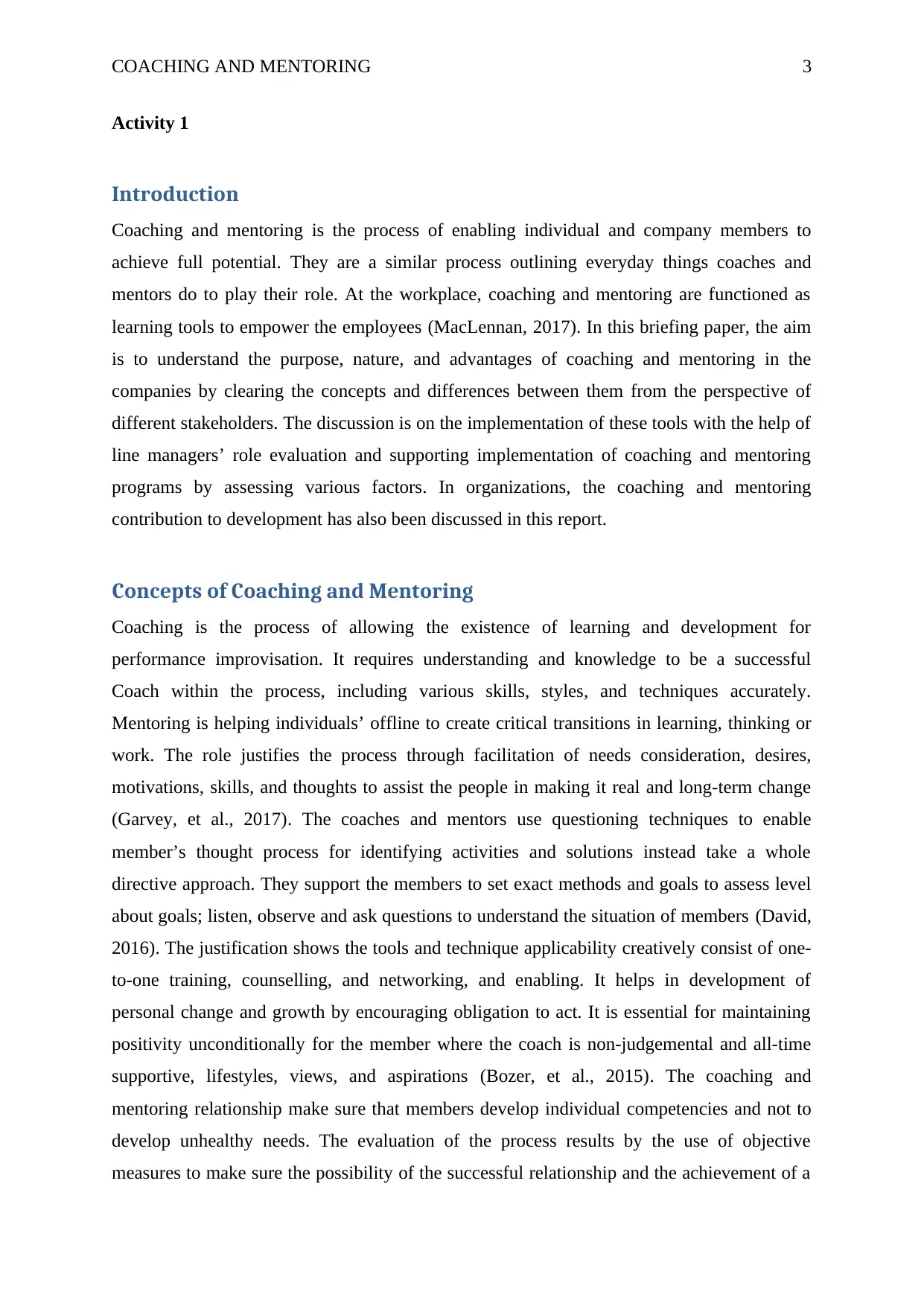
COACHING AND MENTORING 3
Activity 1
Introduction
Coaching and mentoring is the process of enabling individual and company members to
achieve full potential. They are a similar process outlining everyday things coaches and
mentors do to play their role. At the workplace, coaching and mentoring are functioned as
learning tools to empower the employees (MacLennan, 2017). In this briefing paper, the aim
is to understand the purpose, nature, and advantages of coaching and mentoring in the
companies by clearing the concepts and differences between them from the perspective of
different stakeholders. The discussion is on the implementation of these tools with the help of
line managers’ role evaluation and supporting implementation of coaching and mentoring
programs by assessing various factors. In organizations, the coaching and mentoring
contribution to development has also been discussed in this report.
Concepts of Coaching and Mentoring
Coaching is the process of allowing the existence of learning and development for
performance improvisation. It requires understanding and knowledge to be a successful
Coach within the process, including various skills, styles, and techniques accurately.
Mentoring is helping individuals’ offline to create critical transitions in learning, thinking or
work. The role justifies the process through facilitation of needs consideration, desires,
motivations, skills, and thoughts to assist the people in making it real and long-term change
(Garvey, et al., 2017). The coaches and mentors use questioning techniques to enable
member’s thought process for identifying activities and solutions instead take a whole
directive approach. They support the members to set exact methods and goals to assess level
about goals; listen, observe and ask questions to understand the situation of members (David,
2016). The justification shows the tools and technique applicability creatively consist of one-
to-one training, counselling, and networking, and enabling. It helps in development of
personal change and growth by encouraging obligation to act. It is essential for maintaining
positivity unconditionally for the member where the coach is non-judgemental and all-time
supportive, lifestyles, views, and aspirations (Bozer, et al., 2015). The coaching and
mentoring relationship make sure that members develop individual competencies and not to
develop unhealthy needs. The evaluation of the process results by the use of objective
measures to make sure the possibility of the successful relationship and the achievement of a
Activity 1
Introduction
Coaching and mentoring is the process of enabling individual and company members to
achieve full potential. They are a similar process outlining everyday things coaches and
mentors do to play their role. At the workplace, coaching and mentoring are functioned as
learning tools to empower the employees (MacLennan, 2017). In this briefing paper, the aim
is to understand the purpose, nature, and advantages of coaching and mentoring in the
companies by clearing the concepts and differences between them from the perspective of
different stakeholders. The discussion is on the implementation of these tools with the help of
line managers’ role evaluation and supporting implementation of coaching and mentoring
programs by assessing various factors. In organizations, the coaching and mentoring
contribution to development has also been discussed in this report.
Concepts of Coaching and Mentoring
Coaching is the process of allowing the existence of learning and development for
performance improvisation. It requires understanding and knowledge to be a successful
Coach within the process, including various skills, styles, and techniques accurately.
Mentoring is helping individuals’ offline to create critical transitions in learning, thinking or
work. The role justifies the process through facilitation of needs consideration, desires,
motivations, skills, and thoughts to assist the people in making it real and long-term change
(Garvey, et al., 2017). The coaches and mentors use questioning techniques to enable
member’s thought process for identifying activities and solutions instead take a whole
directive approach. They support the members to set exact methods and goals to assess level
about goals; listen, observe and ask questions to understand the situation of members (David,
2016). The justification shows the tools and technique applicability creatively consist of one-
to-one training, counselling, and networking, and enabling. It helps in development of
personal change and growth by encouraging obligation to act. It is essential for maintaining
positivity unconditionally for the member where the coach is non-judgemental and all-time
supportive, lifestyles, views, and aspirations (Bozer, et al., 2015). The coaching and
mentoring relationship make sure that members develop individual competencies and not to
develop unhealthy needs. The evaluation of the process results by the use of objective
measures to make sure the possibility of the successful relationship and the achievement of a
Paraphrase This Document
Need a fresh take? Get an instant paraphrase of this document with our AI Paraphraser
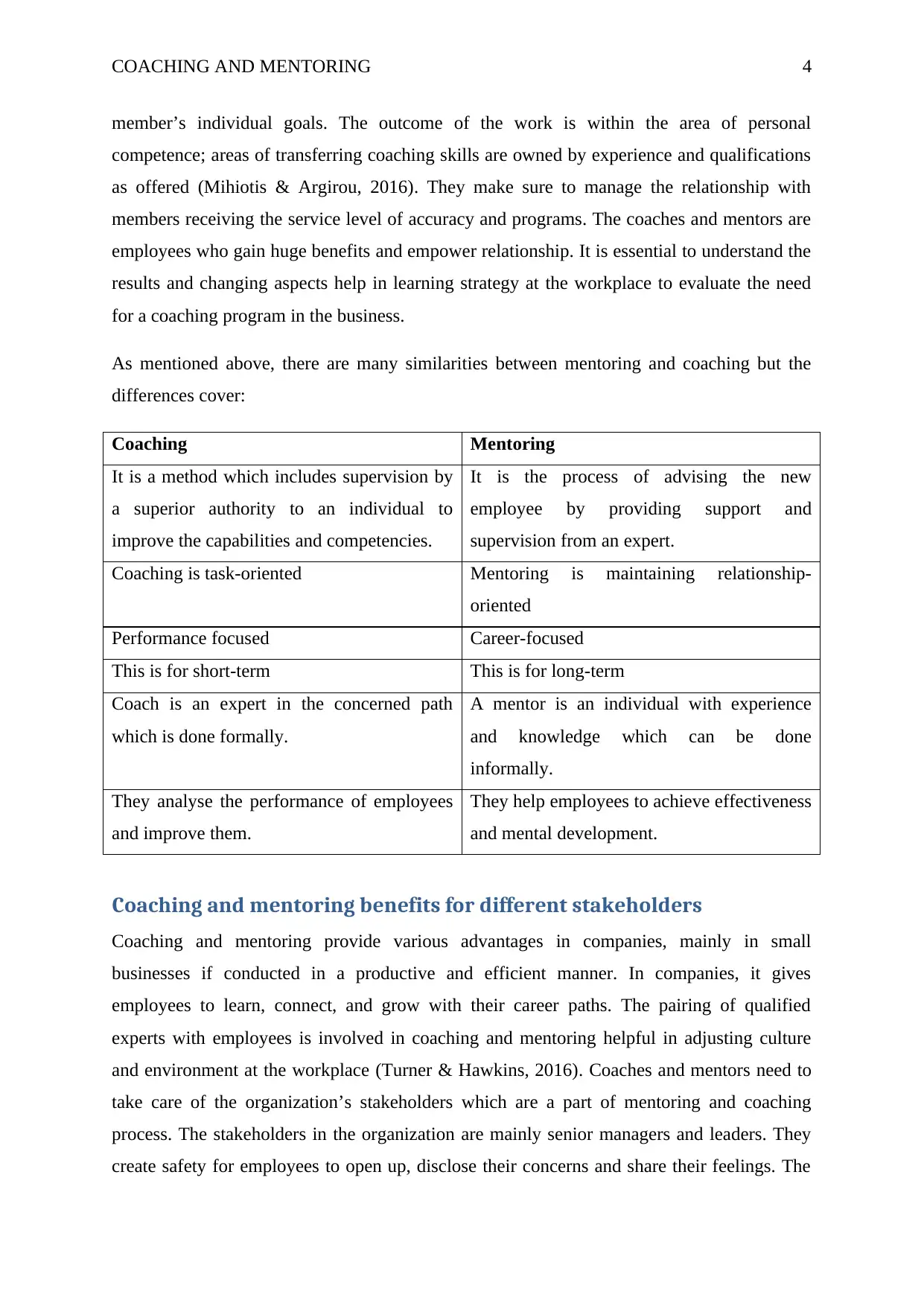
COACHING AND MENTORING 4
member’s individual goals. The outcome of the work is within the area of personal
competence; areas of transferring coaching skills are owned by experience and qualifications
as offered (Mihiotis & Argirou, 2016). They make sure to manage the relationship with
members receiving the service level of accuracy and programs. The coaches and mentors are
employees who gain huge benefits and empower relationship. It is essential to understand the
results and changing aspects help in learning strategy at the workplace to evaluate the need
for a coaching program in the business.
As mentioned above, there are many similarities between mentoring and coaching but the
differences cover:
Coaching Mentoring
It is a method which includes supervision by
a superior authority to an individual to
improve the capabilities and competencies.
It is the process of advising the new
employee by providing support and
supervision from an expert.
Coaching is task-oriented Mentoring is maintaining relationship-
oriented
Performance focused Career-focused
This is for short-term This is for long-term
Coach is an expert in the concerned path
which is done formally.
A mentor is an individual with experience
and knowledge which can be done
informally.
They analyse the performance of employees
and improve them.
They help employees to achieve effectiveness
and mental development.
Coaching and mentoring benefits for different stakeholders
Coaching and mentoring provide various advantages in companies, mainly in small
businesses if conducted in a productive and efficient manner. In companies, it gives
employees to learn, connect, and grow with their career paths. The pairing of qualified
experts with employees is involved in coaching and mentoring helpful in adjusting culture
and environment at the workplace (Turner & Hawkins, 2016). Coaches and mentors need to
take care of the organization’s stakeholders which are a part of mentoring and coaching
process. The stakeholders in the organization are mainly senior managers and leaders. They
create safety for employees to open up, disclose their concerns and share their feelings. The
member’s individual goals. The outcome of the work is within the area of personal
competence; areas of transferring coaching skills are owned by experience and qualifications
as offered (Mihiotis & Argirou, 2016). They make sure to manage the relationship with
members receiving the service level of accuracy and programs. The coaches and mentors are
employees who gain huge benefits and empower relationship. It is essential to understand the
results and changing aspects help in learning strategy at the workplace to evaluate the need
for a coaching program in the business.
As mentioned above, there are many similarities between mentoring and coaching but the
differences cover:
Coaching Mentoring
It is a method which includes supervision by
a superior authority to an individual to
improve the capabilities and competencies.
It is the process of advising the new
employee by providing support and
supervision from an expert.
Coaching is task-oriented Mentoring is maintaining relationship-
oriented
Performance focused Career-focused
This is for short-term This is for long-term
Coach is an expert in the concerned path
which is done formally.
A mentor is an individual with experience
and knowledge which can be done
informally.
They analyse the performance of employees
and improve them.
They help employees to achieve effectiveness
and mental development.
Coaching and mentoring benefits for different stakeholders
Coaching and mentoring provide various advantages in companies, mainly in small
businesses if conducted in a productive and efficient manner. In companies, it gives
employees to learn, connect, and grow with their career paths. The pairing of qualified
experts with employees is involved in coaching and mentoring helpful in adjusting culture
and environment at the workplace (Turner & Hawkins, 2016). Coaches and mentors need to
take care of the organization’s stakeholders which are a part of mentoring and coaching
process. The stakeholders in the organization are mainly senior managers and leaders. They
create safety for employees to open up, disclose their concerns and share their feelings. The

COACHING AND MENTORING 5
support and motivation from the coach as a partner is valued by stakeholders and employee
who is receiving it. Stakeholders and members are busy with their work which is kind of a
hurdle where they are not able to develop ideas or resolve problems. The business models are
applied to do regular activities valued by members and stakeholders with the use of which,
the outcome will be in behavioural change. The one of coaching qualified learners is the
GROW model developed by Sir John Whitmore which covers goals (G), reality (R), options
(O), wrap up (W) providing structure for discussing coaching with qualified learners
(Whitemore, 2002). It can be complicated and time-consuming for less skilled learners. This
model is for the development using a directive approach covering four stages:
At first, the coach focuses on defining goals and expectations to establish and achieve them.
The growth of listening and questioning skills enables the coach to determine the problems to
address. After the identification of the issues, the coach keeps on asking questions for the
availability of options for an employee. Lastly, the actions are examined for the confirmation
of will to act where an employee agrees to do in the meeting (Flückiger, et al., 2017).
Stakeholders of companies increase the confidence value as mentioned to compete and
control the circumstances. Coaching provides decision-making structure and confirms plans,
drives, and plans as well. The leaders develop the performance and potential by value
addition of stakeholders, including self-awareness, self-confidence, and aspects of one’s
personality (Pousa, et al., 2017). The coaching is beneficial for different stakeholders
strategically with the curiosity of how the work is done, how things get done to lead towards
Establish goals
Explore reality
Generate options
Agree action, wrap up
support and motivation from the coach as a partner is valued by stakeholders and employee
who is receiving it. Stakeholders and members are busy with their work which is kind of a
hurdle where they are not able to develop ideas or resolve problems. The business models are
applied to do regular activities valued by members and stakeholders with the use of which,
the outcome will be in behavioural change. The one of coaching qualified learners is the
GROW model developed by Sir John Whitmore which covers goals (G), reality (R), options
(O), wrap up (W) providing structure for discussing coaching with qualified learners
(Whitemore, 2002). It can be complicated and time-consuming for less skilled learners. This
model is for the development using a directive approach covering four stages:
At first, the coach focuses on defining goals and expectations to establish and achieve them.
The growth of listening and questioning skills enables the coach to determine the problems to
address. After the identification of the issues, the coach keeps on asking questions for the
availability of options for an employee. Lastly, the actions are examined for the confirmation
of will to act where an employee agrees to do in the meeting (Flückiger, et al., 2017).
Stakeholders of companies increase the confidence value as mentioned to compete and
control the circumstances. Coaching provides decision-making structure and confirms plans,
drives, and plans as well. The leaders develop the performance and potential by value
addition of stakeholders, including self-awareness, self-confidence, and aspects of one’s
personality (Pousa, et al., 2017). The coaching is beneficial for different stakeholders
strategically with the curiosity of how the work is done, how things get done to lead towards
Establish goals
Explore reality
Generate options
Agree action, wrap up
⊘ This is a preview!⊘
Do you want full access?
Subscribe today to unlock all pages.

Trusted by 1+ million students worldwide
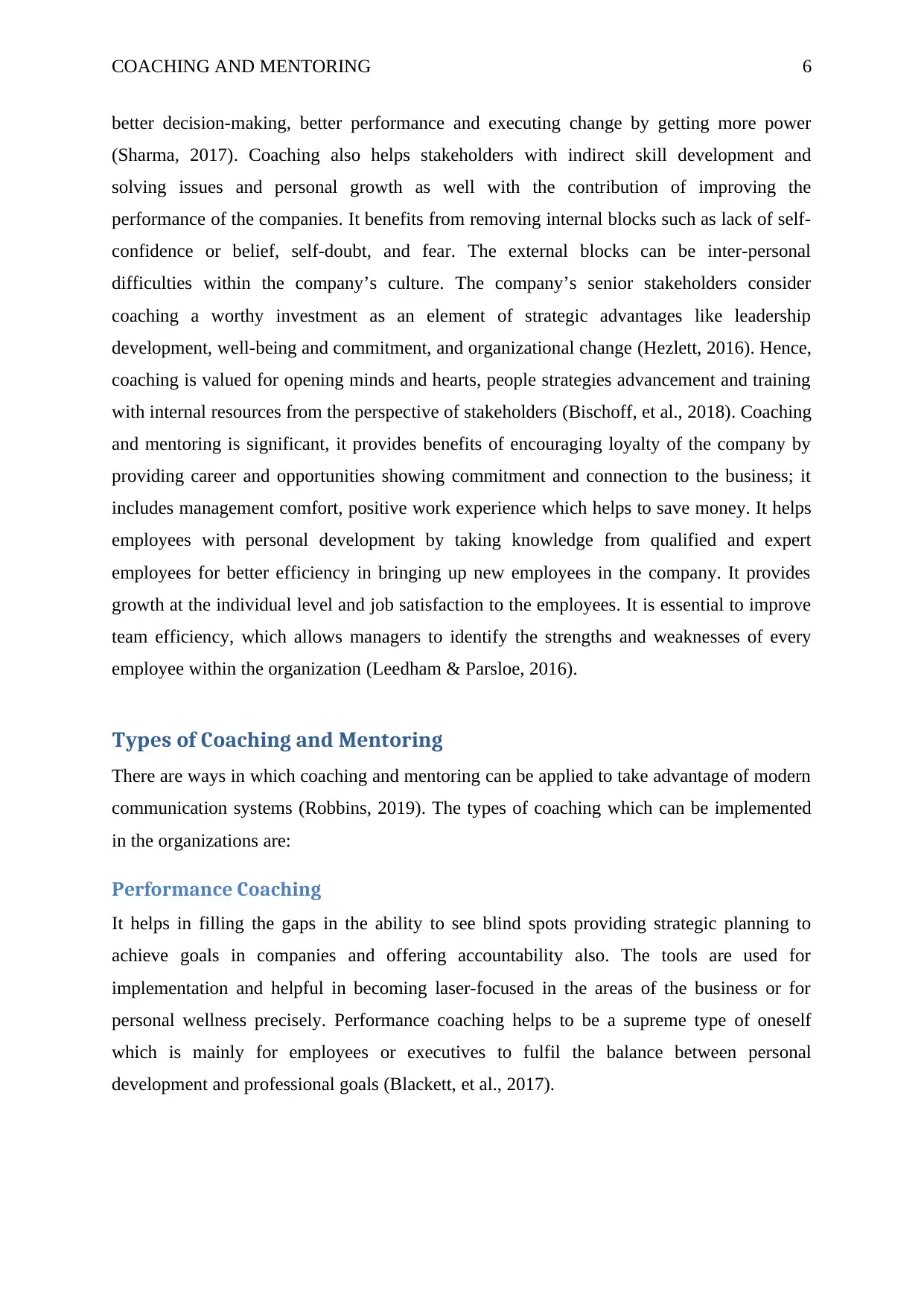
COACHING AND MENTORING 6
better decision-making, better performance and executing change by getting more power
(Sharma, 2017). Coaching also helps stakeholders with indirect skill development and
solving issues and personal growth as well with the contribution of improving the
performance of the companies. It benefits from removing internal blocks such as lack of self-
confidence or belief, self-doubt, and fear. The external blocks can be inter-personal
difficulties within the company’s culture. The company’s senior stakeholders consider
coaching a worthy investment as an element of strategic advantages like leadership
development, well-being and commitment, and organizational change (Hezlett, 2016). Hence,
coaching is valued for opening minds and hearts, people strategies advancement and training
with internal resources from the perspective of stakeholders (Bischoff, et al., 2018). Coaching
and mentoring is significant, it provides benefits of encouraging loyalty of the company by
providing career and opportunities showing commitment and connection to the business; it
includes management comfort, positive work experience which helps to save money. It helps
employees with personal development by taking knowledge from qualified and expert
employees for better efficiency in bringing up new employees in the company. It provides
growth at the individual level and job satisfaction to the employees. It is essential to improve
team efficiency, which allows managers to identify the strengths and weaknesses of every
employee within the organization (Leedham & Parsloe, 2016).
Types of Coaching and Mentoring
There are ways in which coaching and mentoring can be applied to take advantage of modern
communication systems (Robbins, 2019). The types of coaching which can be implemented
in the organizations are:
Performance Coaching
It helps in filling the gaps in the ability to see blind spots providing strategic planning to
achieve goals in companies and offering accountability also. The tools are used for
implementation and helpful in becoming laser-focused in the areas of the business or for
personal wellness precisely. Performance coaching helps to be a supreme type of oneself
which is mainly for employees or executives to fulfil the balance between personal
development and professional goals (Blackett, et al., 2017).
better decision-making, better performance and executing change by getting more power
(Sharma, 2017). Coaching also helps stakeholders with indirect skill development and
solving issues and personal growth as well with the contribution of improving the
performance of the companies. It benefits from removing internal blocks such as lack of self-
confidence or belief, self-doubt, and fear. The external blocks can be inter-personal
difficulties within the company’s culture. The company’s senior stakeholders consider
coaching a worthy investment as an element of strategic advantages like leadership
development, well-being and commitment, and organizational change (Hezlett, 2016). Hence,
coaching is valued for opening minds and hearts, people strategies advancement and training
with internal resources from the perspective of stakeholders (Bischoff, et al., 2018). Coaching
and mentoring is significant, it provides benefits of encouraging loyalty of the company by
providing career and opportunities showing commitment and connection to the business; it
includes management comfort, positive work experience which helps to save money. It helps
employees with personal development by taking knowledge from qualified and expert
employees for better efficiency in bringing up new employees in the company. It provides
growth at the individual level and job satisfaction to the employees. It is essential to improve
team efficiency, which allows managers to identify the strengths and weaknesses of every
employee within the organization (Leedham & Parsloe, 2016).
Types of Coaching and Mentoring
There are ways in which coaching and mentoring can be applied to take advantage of modern
communication systems (Robbins, 2019). The types of coaching which can be implemented
in the organizations are:
Performance Coaching
It helps in filling the gaps in the ability to see blind spots providing strategic planning to
achieve goals in companies and offering accountability also. The tools are used for
implementation and helpful in becoming laser-focused in the areas of the business or for
personal wellness precisely. Performance coaching helps to be a supreme type of oneself
which is mainly for employees or executives to fulfil the balance between personal
development and professional goals (Blackett, et al., 2017).
Paraphrase This Document
Need a fresh take? Get an instant paraphrase of this document with our AI Paraphraser

COACHING AND MENTORING 7
Executive Coaching
Executive coaching is focused on helping top-leaders and managers in the company with
coaching sessions to address the demographic needs specifically. It provides superiors to gain
the skills for managing team and make them attain goals rapidly. In the organization, the
rationale is to invest in executive coaches to make managers perform better with the end of
the coaching process (de Haan, et al., 2016). It is a kind of leadership coaching used in
management for new hiring to play the roles of leaders after the preparation and work like
movers in companies.
Career Coaching
It focuses on helping various personalities of individuals through coaching sessions to work
on problems faced in their careers. For instance, it is hard for a fresher to select a career
direction often to move in as an employee in the company. Individual worked for years as an
employee but still can require career coaching at some point. It can be at the time of
dissatisfaction related to career and want to switch. It helps make a decision and selects an
appropriate job looking at the particular aspects of members to implement (Shoukry & Cox,
2018). Career coaching also helps to succeed in the career individual wants to choose by
skills identification to take the next step as needed in the companies and helpful in
implementing career goals.
The types of mentoring to implement in the companies are:
Line manager mentoring
The line manager is an important stakeholder relating to mentoring, and it will help them to
understand and support the development. The benefits of line manager mentoring can be the
point of valuing the second opinion from an independent perspective with no direct
involvement with the members (Washington & Cox, 2016). It helps in improving the self-
awareness of the members, making better relations between members and employees with
line managers and brings clarity, direction, and a sense of purpose.
Peer mentoring
It helps individuals with the same level of skills provided by training, provides advice,
support, and empathy being at similar positions and making options and career goals (C,
2017). Employees can peer-mentor each other with success for general support or in specific
areas. It is for development and progress, providing support equally to every member. They
Executive Coaching
Executive coaching is focused on helping top-leaders and managers in the company with
coaching sessions to address the demographic needs specifically. It provides superiors to gain
the skills for managing team and make them attain goals rapidly. In the organization, the
rationale is to invest in executive coaches to make managers perform better with the end of
the coaching process (de Haan, et al., 2016). It is a kind of leadership coaching used in
management for new hiring to play the roles of leaders after the preparation and work like
movers in companies.
Career Coaching
It focuses on helping various personalities of individuals through coaching sessions to work
on problems faced in their careers. For instance, it is hard for a fresher to select a career
direction often to move in as an employee in the company. Individual worked for years as an
employee but still can require career coaching at some point. It can be at the time of
dissatisfaction related to career and want to switch. It helps make a decision and selects an
appropriate job looking at the particular aspects of members to implement (Shoukry & Cox,
2018). Career coaching also helps to succeed in the career individual wants to choose by
skills identification to take the next step as needed in the companies and helpful in
implementing career goals.
The types of mentoring to implement in the companies are:
Line manager mentoring
The line manager is an important stakeholder relating to mentoring, and it will help them to
understand and support the development. The benefits of line manager mentoring can be the
point of valuing the second opinion from an independent perspective with no direct
involvement with the members (Washington & Cox, 2016). It helps in improving the self-
awareness of the members, making better relations between members and employees with
line managers and brings clarity, direction, and a sense of purpose.
Peer mentoring
It helps individuals with the same level of skills provided by training, provides advice,
support, and empathy being at similar positions and making options and career goals (C,
2017). Employees can peer-mentor each other with success for general support or in specific
areas. It is for development and progress, providing support equally to every member. They
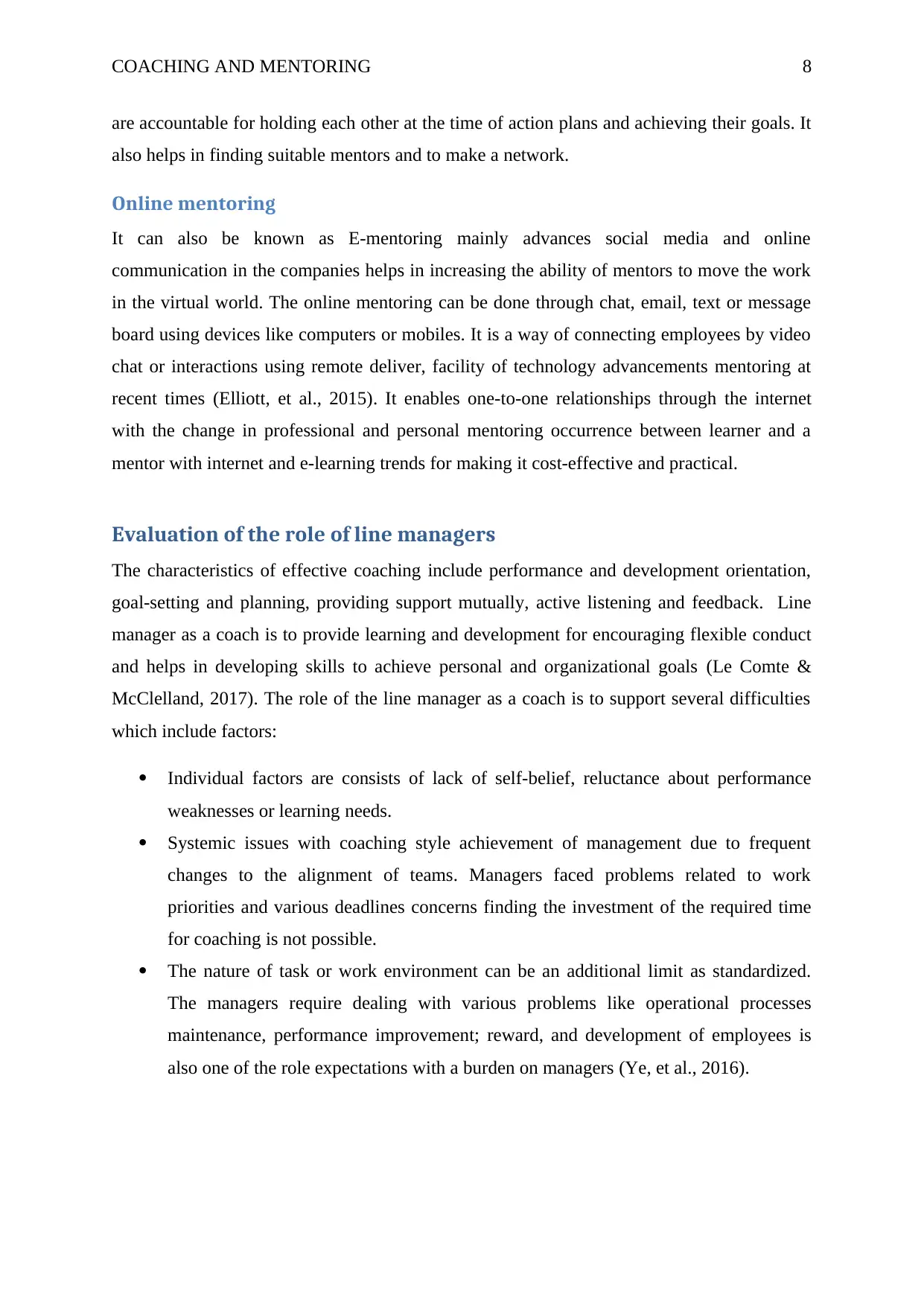
COACHING AND MENTORING 8
are accountable for holding each other at the time of action plans and achieving their goals. It
also helps in finding suitable mentors and to make a network.
Online mentoring
It can also be known as E-mentoring mainly advances social media and online
communication in the companies helps in increasing the ability of mentors to move the work
in the virtual world. The online mentoring can be done through chat, email, text or message
board using devices like computers or mobiles. It is a way of connecting employees by video
chat or interactions using remote deliver, facility of technology advancements mentoring at
recent times (Elliott, et al., 2015). It enables one-to-one relationships through the internet
with the change in professional and personal mentoring occurrence between learner and a
mentor with internet and e-learning trends for making it cost-effective and practical.
Evaluation of the role of line managers
The characteristics of effective coaching include performance and development orientation,
goal-setting and planning, providing support mutually, active listening and feedback. Line
manager as a coach is to provide learning and development for encouraging flexible conduct
and helps in developing skills to achieve personal and organizational goals (Le Comte &
McClelland, 2017). The role of the line manager as a coach is to support several difficulties
which include factors:
Individual factors are consists of lack of self-belief, reluctance about performance
weaknesses or learning needs.
Systemic issues with coaching style achievement of management due to frequent
changes to the alignment of teams. Managers faced problems related to work
priorities and various deadlines concerns finding the investment of the required time
for coaching is not possible.
The nature of task or work environment can be an additional limit as standardized.
The managers require dealing with various problems like operational processes
maintenance, performance improvement; reward, and development of employees is
also one of the role expectations with a burden on managers (Ye, et al., 2016).
are accountable for holding each other at the time of action plans and achieving their goals. It
also helps in finding suitable mentors and to make a network.
Online mentoring
It can also be known as E-mentoring mainly advances social media and online
communication in the companies helps in increasing the ability of mentors to move the work
in the virtual world. The online mentoring can be done through chat, email, text or message
board using devices like computers or mobiles. It is a way of connecting employees by video
chat or interactions using remote deliver, facility of technology advancements mentoring at
recent times (Elliott, et al., 2015). It enables one-to-one relationships through the internet
with the change in professional and personal mentoring occurrence between learner and a
mentor with internet and e-learning trends for making it cost-effective and practical.
Evaluation of the role of line managers
The characteristics of effective coaching include performance and development orientation,
goal-setting and planning, providing support mutually, active listening and feedback. Line
manager as a coach is to provide learning and development for encouraging flexible conduct
and helps in developing skills to achieve personal and organizational goals (Le Comte &
McClelland, 2017). The role of the line manager as a coach is to support several difficulties
which include factors:
Individual factors are consists of lack of self-belief, reluctance about performance
weaknesses or learning needs.
Systemic issues with coaching style achievement of management due to frequent
changes to the alignment of teams. Managers faced problems related to work
priorities and various deadlines concerns finding the investment of the required time
for coaching is not possible.
The nature of task or work environment can be an additional limit as standardized.
The managers require dealing with various problems like operational processes
maintenance, performance improvement; reward, and development of employees is
also one of the role expectations with a burden on managers (Ye, et al., 2016).
⊘ This is a preview!⊘
Do you want full access?
Subscribe today to unlock all pages.

Trusted by 1+ million students worldwide

COACHING AND MENTORING 9
Factors considered at the time of Coaching and Mentoring
implementation
There are various factors which are necessary to be supposed to implement coaching and to
mentor in the organization which are affected by values, culture, objectives, and structure that
needs to be possibly aligned for the success and employees betterment. It requires the L&D
strategy broadly with real advantages for managers to develop skills and support employees
for achievement of goals in the company. Coaching is given by workforce members or by
external coaches, where line managers take the utmost responsibility to provide coaching. It
is a daily management activity done at the time of performance conversations and one-to-one
meetings. The issue is of managers raising employees effectively, giving power and
impartiality and distance needed at what pace in the coaching relationship (Augustine-Shaw,
2015).
The involvement of structured opportunities in coaching to reflect the activities are
challenging for coaches as well providing support and help to develop skills of employees
through coaching sessions. It is necessary to create trust between the coach and individual
and stakeholders as well by implementing guidelines on the flow of information and
confidentiality. It is the role of HR and L&D (learning and development) departments to
manage and design to mentor and coaching in the company. Coaches and mentors success
evaluation and relationship management shows the quality of coaching and results delivery.
The models like COACH (concept, outcomes, application, commitment, high performance)
approach is used for credits, accuracy, and relevancy needed in coaching and mentoring to
match organizational and individual needs (Cullen, 2012). Another factor to be considered is
financial implications because organization has to ensure that the activities performed under
the coaching and mentoring necessary to be in the budget. While providing coaching for
developing IT skills of employees, companies can rely on online mentoring services to reduce
the cost incurred on in-house coaches and mentors. The issues of diversity can also be
considered as another factor for problem-solving, business growth and opportunities by
proper implementation of coaching and mentoring in the company for employees to accept
the culture and engagement improvisation with the development of support systems (Tompa,
et al., 2016).
Factors considered at the time of Coaching and Mentoring
implementation
There are various factors which are necessary to be supposed to implement coaching and to
mentor in the organization which are affected by values, culture, objectives, and structure that
needs to be possibly aligned for the success and employees betterment. It requires the L&D
strategy broadly with real advantages for managers to develop skills and support employees
for achievement of goals in the company. Coaching is given by workforce members or by
external coaches, where line managers take the utmost responsibility to provide coaching. It
is a daily management activity done at the time of performance conversations and one-to-one
meetings. The issue is of managers raising employees effectively, giving power and
impartiality and distance needed at what pace in the coaching relationship (Augustine-Shaw,
2015).
The involvement of structured opportunities in coaching to reflect the activities are
challenging for coaches as well providing support and help to develop skills of employees
through coaching sessions. It is necessary to create trust between the coach and individual
and stakeholders as well by implementing guidelines on the flow of information and
confidentiality. It is the role of HR and L&D (learning and development) departments to
manage and design to mentor and coaching in the company. Coaches and mentors success
evaluation and relationship management shows the quality of coaching and results delivery.
The models like COACH (concept, outcomes, application, commitment, high performance)
approach is used for credits, accuracy, and relevancy needed in coaching and mentoring to
match organizational and individual needs (Cullen, 2012). Another factor to be considered is
financial implications because organization has to ensure that the activities performed under
the coaching and mentoring necessary to be in the budget. While providing coaching for
developing IT skills of employees, companies can rely on online mentoring services to reduce
the cost incurred on in-house coaches and mentors. The issues of diversity can also be
considered as another factor for problem-solving, business growth and opportunities by
proper implementation of coaching and mentoring in the company for employees to accept
the culture and engagement improvisation with the development of support systems (Tompa,
et al., 2016).
Paraphrase This Document
Need a fresh take? Get an instant paraphrase of this document with our AI Paraphraser
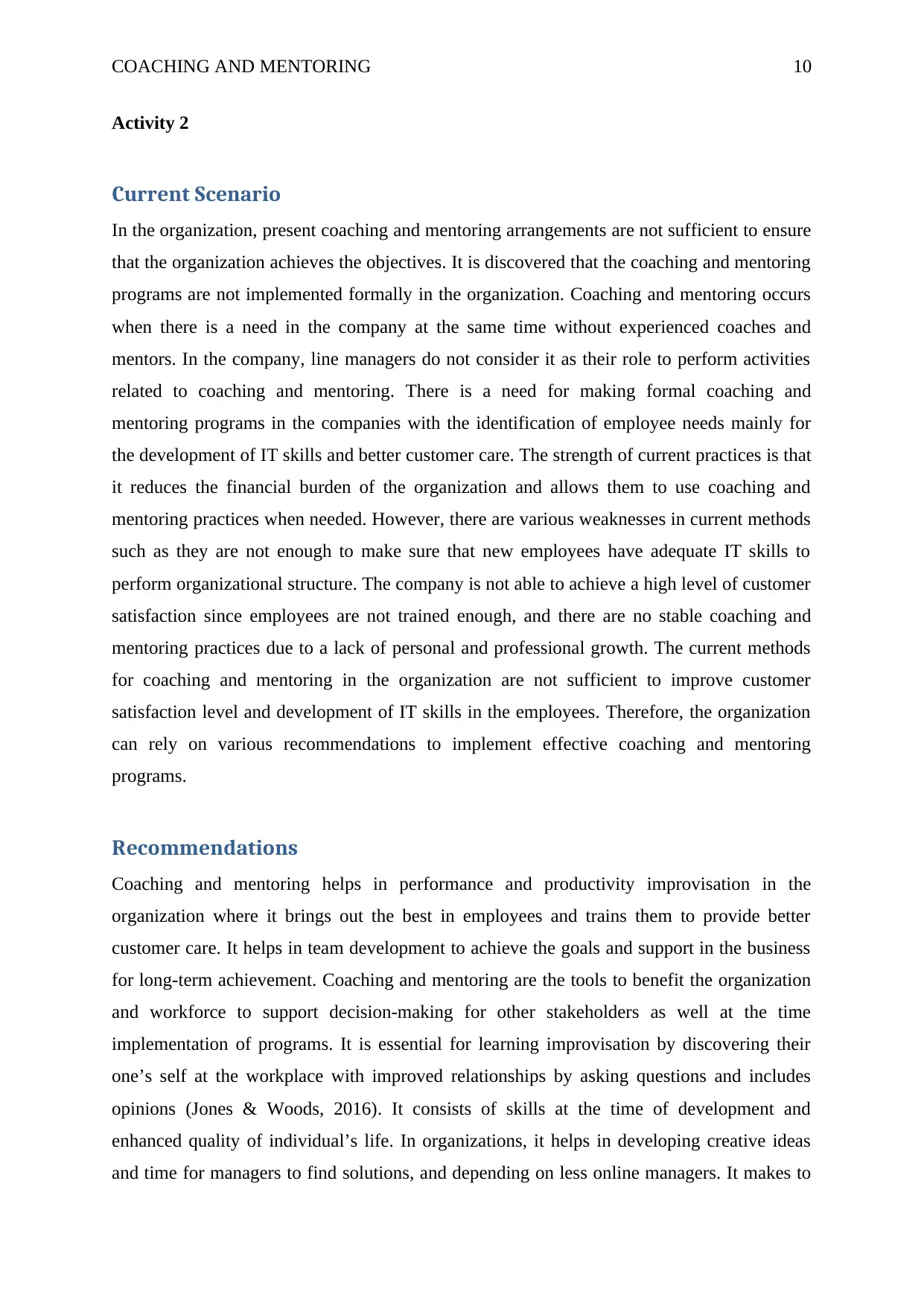
COACHING AND MENTORING 10
Activity 2
Current Scenario
In the organization, present coaching and mentoring arrangements are not sufficient to ensure
that the organization achieves the objectives. It is discovered that the coaching and mentoring
programs are not implemented formally in the organization. Coaching and mentoring occurs
when there is a need in the company at the same time without experienced coaches and
mentors. In the company, line managers do not consider it as their role to perform activities
related to coaching and mentoring. There is a need for making formal coaching and
mentoring programs in the companies with the identification of employee needs mainly for
the development of IT skills and better customer care. The strength of current practices is that
it reduces the financial burden of the organization and allows them to use coaching and
mentoring practices when needed. However, there are various weaknesses in current methods
such as they are not enough to make sure that new employees have adequate IT skills to
perform organizational structure. The company is not able to achieve a high level of customer
satisfaction since employees are not trained enough, and there are no stable coaching and
mentoring practices due to a lack of personal and professional growth. The current methods
for coaching and mentoring in the organization are not sufficient to improve customer
satisfaction level and development of IT skills in the employees. Therefore, the organization
can rely on various recommendations to implement effective coaching and mentoring
programs.
Recommendations
Coaching and mentoring helps in performance and productivity improvisation in the
organization where it brings out the best in employees and trains them to provide better
customer care. It helps in team development to achieve the goals and support in the business
for long-term achievement. Coaching and mentoring are the tools to benefit the organization
and workforce to support decision-making for other stakeholders as well at the time
implementation of programs. It is essential for learning improvisation by discovering their
one’s self at the workplace with improved relationships by asking questions and includes
opinions (Jones & Woods, 2016). It consists of skills at the time of development and
enhanced quality of individual’s life. In organizations, it helps in developing creative ideas
and time for managers to find solutions, and depending on less online managers. It makes to
Activity 2
Current Scenario
In the organization, present coaching and mentoring arrangements are not sufficient to ensure
that the organization achieves the objectives. It is discovered that the coaching and mentoring
programs are not implemented formally in the organization. Coaching and mentoring occurs
when there is a need in the company at the same time without experienced coaches and
mentors. In the company, line managers do not consider it as their role to perform activities
related to coaching and mentoring. There is a need for making formal coaching and
mentoring programs in the companies with the identification of employee needs mainly for
the development of IT skills and better customer care. The strength of current practices is that
it reduces the financial burden of the organization and allows them to use coaching and
mentoring practices when needed. However, there are various weaknesses in current methods
such as they are not enough to make sure that new employees have adequate IT skills to
perform organizational structure. The company is not able to achieve a high level of customer
satisfaction since employees are not trained enough, and there are no stable coaching and
mentoring practices due to a lack of personal and professional growth. The current methods
for coaching and mentoring in the organization are not sufficient to improve customer
satisfaction level and development of IT skills in the employees. Therefore, the organization
can rely on various recommendations to implement effective coaching and mentoring
programs.
Recommendations
Coaching and mentoring helps in performance and productivity improvisation in the
organization where it brings out the best in employees and trains them to provide better
customer care. It helps in team development to achieve the goals and support in the business
for long-term achievement. Coaching and mentoring are the tools to benefit the organization
and workforce to support decision-making for other stakeholders as well at the time
implementation of programs. It is essential for learning improvisation by discovering their
one’s self at the workplace with improved relationships by asking questions and includes
opinions (Jones & Woods, 2016). It consists of skills at the time of development and
enhanced quality of individual’s life. In organizations, it helps in developing creative ideas
and time for managers to find solutions, and depending on less online managers. It makes to
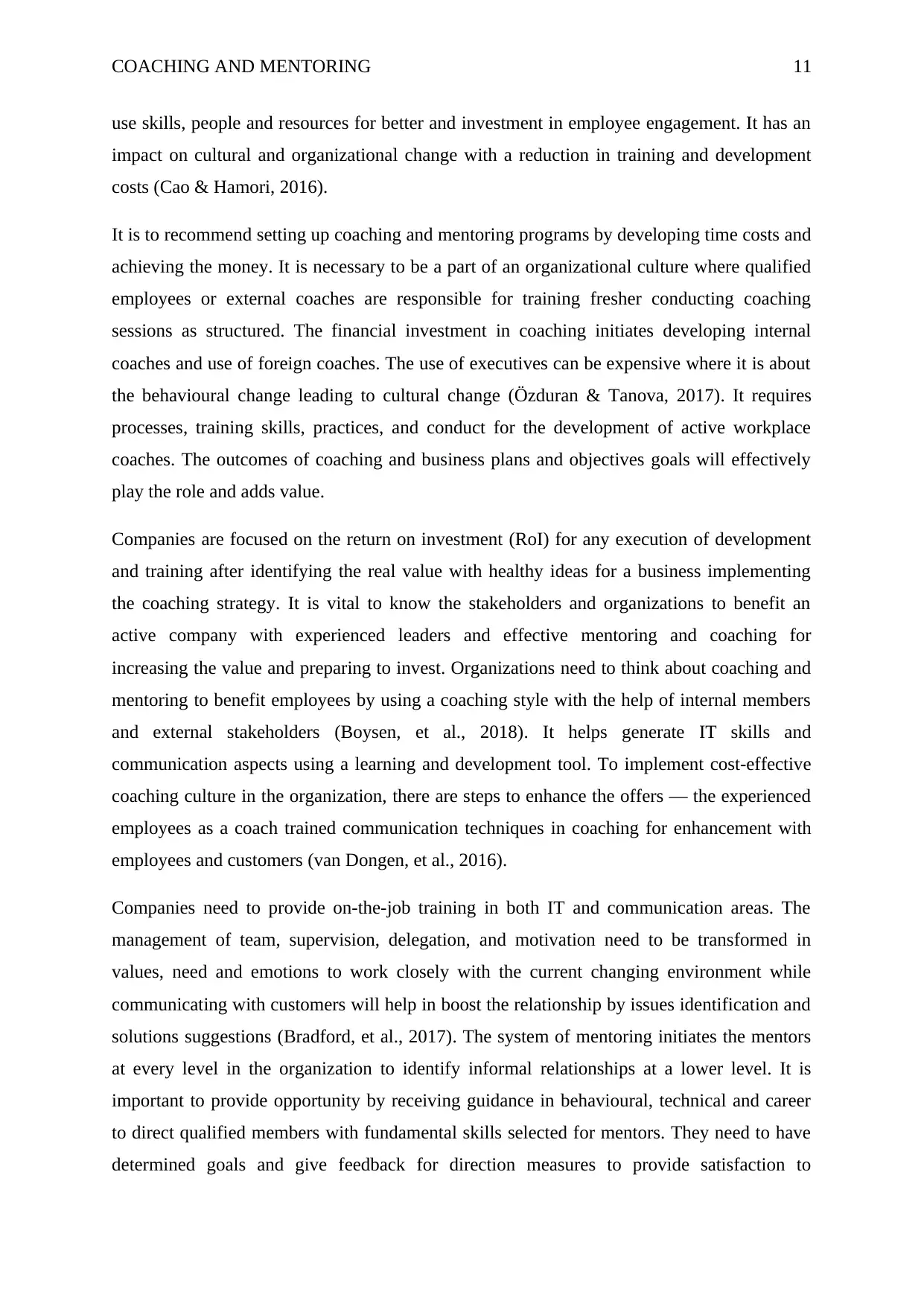
COACHING AND MENTORING 11
use skills, people and resources for better and investment in employee engagement. It has an
impact on cultural and organizational change with a reduction in training and development
costs (Cao & Hamori, 2016).
It is to recommend setting up coaching and mentoring programs by developing time costs and
achieving the money. It is necessary to be a part of an organizational culture where qualified
employees or external coaches are responsible for training fresher conducting coaching
sessions as structured. The financial investment in coaching initiates developing internal
coaches and use of foreign coaches. The use of executives can be expensive where it is about
the behavioural change leading to cultural change (Özduran & Tanova, 2017). It requires
processes, training skills, practices, and conduct for the development of active workplace
coaches. The outcomes of coaching and business plans and objectives goals will effectively
play the role and adds value.
Companies are focused on the return on investment (RoI) for any execution of development
and training after identifying the real value with healthy ideas for a business implementing
the coaching strategy. It is vital to know the stakeholders and organizations to benefit an
active company with experienced leaders and effective mentoring and coaching for
increasing the value and preparing to invest. Organizations need to think about coaching and
mentoring to benefit employees by using a coaching style with the help of internal members
and external stakeholders (Boysen, et al., 2018). It helps generate IT skills and
communication aspects using a learning and development tool. To implement cost-effective
coaching culture in the organization, there are steps to enhance the offers — the experienced
employees as a coach trained communication techniques in coaching for enhancement with
employees and customers (van Dongen, et al., 2016).
Companies need to provide on-the-job training in both IT and communication areas. The
management of team, supervision, delegation, and motivation need to be transformed in
values, need and emotions to work closely with the current changing environment while
communicating with customers will help in boost the relationship by issues identification and
solutions suggestions (Bradford, et al., 2017). The system of mentoring initiates the mentors
at every level in the organization to identify informal relationships at a lower level. It is
important to provide opportunity by receiving guidance in behavioural, technical and career
to direct qualified members with fundamental skills selected for mentors. They need to have
determined goals and give feedback for direction measures to provide satisfaction to
use skills, people and resources for better and investment in employee engagement. It has an
impact on cultural and organizational change with a reduction in training and development
costs (Cao & Hamori, 2016).
It is to recommend setting up coaching and mentoring programs by developing time costs and
achieving the money. It is necessary to be a part of an organizational culture where qualified
employees or external coaches are responsible for training fresher conducting coaching
sessions as structured. The financial investment in coaching initiates developing internal
coaches and use of foreign coaches. The use of executives can be expensive where it is about
the behavioural change leading to cultural change (Özduran & Tanova, 2017). It requires
processes, training skills, practices, and conduct for the development of active workplace
coaches. The outcomes of coaching and business plans and objectives goals will effectively
play the role and adds value.
Companies are focused on the return on investment (RoI) for any execution of development
and training after identifying the real value with healthy ideas for a business implementing
the coaching strategy. It is vital to know the stakeholders and organizations to benefit an
active company with experienced leaders and effective mentoring and coaching for
increasing the value and preparing to invest. Organizations need to think about coaching and
mentoring to benefit employees by using a coaching style with the help of internal members
and external stakeholders (Boysen, et al., 2018). It helps generate IT skills and
communication aspects using a learning and development tool. To implement cost-effective
coaching culture in the organization, there are steps to enhance the offers — the experienced
employees as a coach trained communication techniques in coaching for enhancement with
employees and customers (van Dongen, et al., 2016).
Companies need to provide on-the-job training in both IT and communication areas. The
management of team, supervision, delegation, and motivation need to be transformed in
values, need and emotions to work closely with the current changing environment while
communicating with customers will help in boost the relationship by issues identification and
solutions suggestions (Bradford, et al., 2017). The system of mentoring initiates the mentors
at every level in the organization to identify informal relationships at a lower level. It is
important to provide opportunity by receiving guidance in behavioural, technical and career
to direct qualified members with fundamental skills selected for mentors. They need to have
determined goals and give feedback for direction measures to provide satisfaction to
⊘ This is a preview!⊘
Do you want full access?
Subscribe today to unlock all pages.

Trusted by 1+ million students worldwide
1 out of 19
Related Documents
Your All-in-One AI-Powered Toolkit for Academic Success.
+13062052269
info@desklib.com
Available 24*7 on WhatsApp / Email
![[object Object]](/_next/static/media/star-bottom.7253800d.svg)
Unlock your academic potential
Copyright © 2020–2025 A2Z Services. All Rights Reserved. Developed and managed by ZUCOL.





